The
Masque of Red Death
1964
Director: Roger Corman
Starring: Vincent Price, Jane Asher,
Hazel Court, Patrick Magee
Old
school horror films like The Masque of Red Death are
certainly very different from the horror films of today. Is it scary?
Not exactly, not ‘scary’ in what I’d consider a typical manner. But having said that, I think that today’s
horror films could learn a lesson or three from horror classics like this.
Based,
like so many other Corman movies, on an Edgar Allen Poe story, The
Masque of Red Death focuses on evil Prince Prospero (Price) who
retreats to his castle when the vicious plague the Red Death comes to the
village in his land. He abducts peasant
Francesca (Asher) to keep as his new pet, a fact that displeases the Lady
Juliana (Court). Prospero eventually
reveals to Francesca that he is a Satanist and he attempts to teach her his
religion, while Prospero’s friend Alfredo (Magee) generally looks evil and acts
dastardly in the background.
There
are several moments of honest to god creepiness in The Masque of Red Death. Take Prospero’s speech about terror in the
court scene early in the film. “What is
terror?” he asks. The fact that the
court falls so suddenly quiet to listen to Vincent Price’s lyric and
hypnotizing voice, which echoes ever so slightly, as Price speaks such eloquent
yet disconcerting words, and yeah, it’s creepy.
The dwarf dancer Hop-toad exacts an incredibly vicious, if not undeserving,
death on a character that is absolutely horrifying to watch, especially if you
know what he’s planning all along. To
watch him so coldly and seductively ensnare the character in question into his
trap is chilling. And lastly, the whole
of Prospero’s court I found rather disturbing.
The people Prospero has surrounded himself obey his every word without a
single question; they actually delight in doing his bizarre and cruel bidding. He’s a sadist who has found twenty odd
masochists who will do whatever he asks.
In said early court scene, Prospero starts ordering his court members to
act like animals for him. They do, and
everyone laughs at them. It’s not the
laughing, the mocking that’s disturbing in this scene, oh no. No, it’s the relish with which the lords and
ladies carry out Prospero’s ridiculous wishes.
Act like a donkey? Absolutely,
nothing would make me happier! This is
so disconcerting that it gives the whole scene a thoroughly creepy atmosphere,
despite all of the laughing characters.
All of these moments, however, are heightened by the awesome production value of The Masque of Red Death. By filming in England, Corman was able to make his money go further and also use many of the castle sets from Becket. The Masque of Red Death is a gorgeous movie, there is no denying it. With brilliant colorwork and cinematography by none less than Nicolas Roeg, you will not get bored looking at this film. Brilliant greens and blues and reds pop off the screen, and the costumes are just as sumptuous. A highlight are the “colored rooms,” one each of nothing but yellow, purple, white, then black. I even noticed the candles in the film. They aren’t simply white candles, oh no, that’s too normal. No, the candles color match their respective rooms, and even in the banquet hall, they are bright blue or green. Horror films today shy away from color like it’s the plague, delighting in shadows and darks and blacks and greys. The Masque of Red Death proves you can make a creepy film that is drenched in primary colors and filled with lush costumes. The film hardly looks realistic, but what does that matter if it creates such an atmosphere?
All
this isn’t to say the film is without flaws.
It’s certainly dated in some aspects, but less so than other B movie
counterparts of its time. I can easily
forgive that. No, my biggest confusion
with The
Masque of Red Death was in Prospero’s character. I didn’t understand his random acts of
kindness. He’s supposed to be our Evil
Genius of Evil, and yet he gets overcome with unexplained sympathy for humanity
at the oddest of times. For example,
take Francesca. He keeps on making vague
threats to her, but never follows through on any of them. He even treats her, dare I say it, well. Sure, he kills everyone around her and treats
those she loves with cruelty and violence, but to Francesca, he’s a positive
lamb. He doesn’t even try to come on to
her in any way. He protects her from the
other madmen in his keep, even protects her from the Red Death. And then there’s a scene where he orders the
execution of six villagers, but spares the life of a young girl. Why spare the life of the little girl? It’s so out of character, or at least it
doesn’t fall in line with expectations for what an Evil Genius should be. Given how utterly cruel he is to everyone in
the film, his acts of kindness are just… weird.
But
really, I suppose I shouldn’t be too nitpicky at a fun schlock fest that
actually manages to be legitimately creepy, especially given that they just don’t
make ‘em like this anymore. I love the
language and the colors and the cinematography.
I wouldn’t say I totally love the movie overall, as it’s not exactly my
style, but I appreciate the hell out of it.
Bring back gothic horror films, I say!
Arbitrary
Rating: 7/10

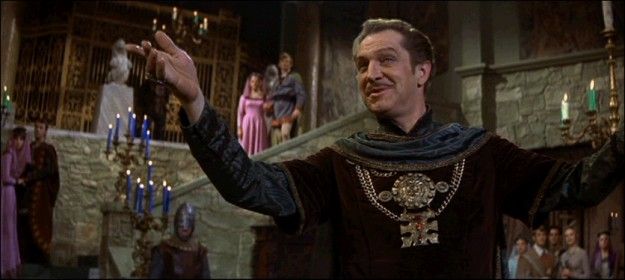
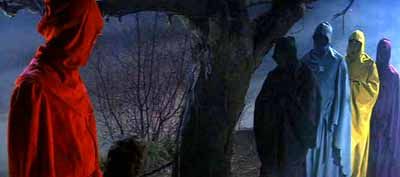
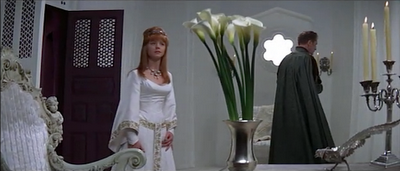
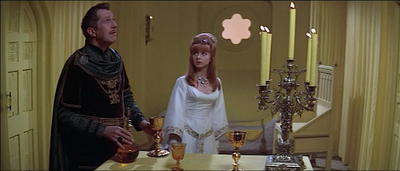
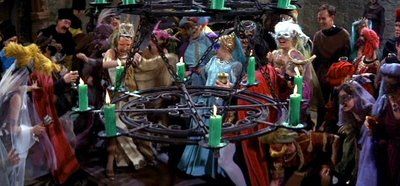
I don't have much taste for horror, but as you pointed out, older horror films are almost nothing like what is produced today. I started watching this with a "let's get this over with" attitude and ended up liking it.
ReplyDeleteI didn't have a problem with the "kindness" since for a large part of the film it wasn't kindness: it was psychological torture. He is hurting all the people around her, including ones she cares about. He eventually comes to care for her, though, so he spares her for real. And most of the people who die "deserved" to die (in the morality of the time of the tale) because they are ardent sinners. She is not, and the little girl is also an innocent.
I also liked the ending where we saw other "Deaths" in all hues. You could speculate on what kind of death each of those colors represented.
I think the fact that he came to care for her boggled my mind, which made me just go "huh?" But as I said, it's a minor quibble.
DeleteI like it when a "let's get this over with" movie turns into a good surprise.
The epilogue with the other colored monks/"deaths" was so cool, a great way to cap off the film. The yellow one I figured was Yellow Death, but what about purple? Or blue? Hmmmm.... Maybe blue is asphyxiation.
I love this one (big surprise, right?) for a lot of the reasons you mention. One of my favorite moments is when Vincent Price gets to announce his allegiance to Satan when talking to his virginal intended victim. He says it with such a scenery-chewing relish that I take genuine pleasure in watching him.
ReplyDeleteThis one is all about the look, the bold splotches of color and garishness and Vincent Price's amazing ability to gnaw scenery with the best of them.
The look is really incredibly, definitely my favorite part. And Price is so good, he really carries the film.
Delete"gnaw the scenery."
Indeed!!
I love this movie too, mainly because of Vincent Price and his amazing voice, but also because of the beautiful bright colors permeating everything. It's like a movie made of skittles.
ReplyDelete"a movie made of skittles"
DeleteA very apt way to put it! You wouldn't think such bright colors would work with horror, but they really do. It's such a gorgeous, creepy movie!
Love me some Vincent Price. I've become more and more fond of old horror movies and liked this one a lot. I hope I can develop some tolerance for the newer and gorier ones because I intentionally skipped most of them and so have a lot remaining unviewed on my List.
ReplyDeleteI have very little tolerance for gore, so I definitely prefer the older, classic horror films that are more about atmosphere than explicit violence. I'm with ya on that issue!!!
Delete